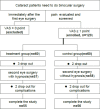Hypnosis intervention for the management of pain perception during cataract surgery
- PMID: 30288086
- PMCID: PMC6160280
- DOI: 10.2147/JPR.S174490
Hypnosis intervention for the management of pain perception during cataract surgery
Erratum in
-
Erratum: Hypnosis intervention for the management of pain perception during cataract surgery [Erratum].J Pain Res. 2019 Jan 23;12:489. doi: 10.2147/JPR.S201749. eCollection 2019. J Pain Res. 2019. PMID: 30774418 Free PMC article.
Abstract
Objective: To investigate the effectiveness of hypnosis in pain management during cataract surgery.
Methods: Male or female patients with bilateral age-related cataract who wished to have both eyes subjected to phacoemulsification surgery were preliminarily admitted. Immediately after the first-eye surgery, each patient was evaluated for pain using the visual analog scale (VAS), and patients with a VAS score >1 were enrolled. By using block randomization, the enrolled patients were allocated to either the treatment group, which received a hypnosis intervention before the scheduled second-eye surgery, or the control group, which did not undergo hypnosis. The levels of anxiety, pain, and cooperation were evaluated independently by the patients and the surgeon.
Results: During the intraoperative pain assessment, 5%, 34%, 38%, and 23% of patients in the control group reported experiencing no pain, mild pain, moderate pain, and severe pain, respectively. In contrast, in the hypnosis group, 18%, 56%, 15%, and 11% of patients reported experiencing no pain, mild pain, moderate pain, and severe pain, respectively, which showed significant differences between the groups (P<0.005). The evaluation of anxiety level showed that the mean score in the control group and hypnosis group was 11.77±0.32 and 6.64±0.21, respectively, revealing a highly significant difference between the two groups (P<0.005). The assessment of patient cooperation showed that only 5% and 18% of patients in the control group and 18% and 36% of patients in the hypnosis group showed excellent and good cooperation, respectively, while 47% of patients in the control group and only 24% of patients in the hypnosis group exhibited poor cooperation, revealing significant differences between the groups (P<0.005).
Conclusion: Hypnosis may be considered as an auxiliary measure in cataract surgery, especially for patients who experienced obvious pain during the first-eye surgery.
Keywords: cataract surgery; hypnosis; pain; patient satisfaction.
Conflict of interest statement
Disclosure The authors report no conflicts of interest in this work.
Figures





Similar articles
-
[Prevalence and causes of pain after cataract surgery: Comparison of 1st and 2nd eyes].J Fr Ophtalmol. 2017 Jun;40(6):505-511. doi: 10.1016/j.jfo.2016.11.028. Epub 2017 May 30. J Fr Ophtalmol. 2017. PMID: 28571837 French.
-
Dynamic monocyte chemoattractant protein-1 level as predictors of perceived pain during first and second phacoemulsification eye surgeries in patients with bilateral cataract.BMC Ophthalmol. 2021 Mar 12;21(1):133. doi: 10.1186/s12886-021-01880-z. BMC Ophthalmol. 2021. PMID: 33711968 Free PMC article.
-
Do Consecutive Phacoemulsification Surgeries Under Topical Anesthesia Differ in Terms of Pain Perception and Cooperation?Cureus. 2021 Nov 26;13(11):e19915. doi: 10.7759/cureus.19915. eCollection 2021 Nov. Cureus. 2021. PMID: 34966612 Free PMC article.
-
The role of clinical hypnosis and self-hypnosis to relief pain and anxiety in severe chronic diseases in palliative care: a 2-year long-term follow-up of treatment in a nonrandomized clinical trial.Ann Palliat Med. 2018 Jan;7(1):17-31. doi: 10.21037/apm.2017.10.03. Epub 2017 Dec 12. Ann Palliat Med. 2018. PMID: 29307207
-
Differences in pain experience and cooperation between consecutive surgeries in patients undergoing phacoemulsification.Int Ophthalmol. 2017 Jun;37(3):545-552. doi: 10.1007/s10792-016-0295-3. Epub 2016 Jul 23. Int Ophthalmol. 2017. PMID: 27450789 Clinical Trial.
Cited by
-
Suggested deafness during hypnosis and simulation of hypnosis compared to a distraction and control condition: A study on subjective experience and cortical brain responses.PLoS One. 2020 Oct 29;15(10):e0240832. doi: 10.1371/journal.pone.0240832. eCollection 2020. PLoS One. 2020. PMID: 33119665 Free PMC article.
-
Adjunctive use of hypnosis for clinical pain: a systematic review and meta-analysis.Pain Rep. 2024 Sep 10;9(5):e1185. doi: 10.1097/PR9.0000000000001185. eCollection 2024 Oct. Pain Rep. 2024. PMID: 39263007 Free PMC article. Review.
-
Comparison in Sedative Effects between Dexmedetomidine and Midazolam in Dental Implantation: A Randomized Clinical Trial.Biomed Res Int. 2020 Jun 2;2020:6130162. doi: 10.1155/2020/6130162. eCollection 2020. Biomed Res Int. 2020. PMID: 32596337 Free PMC article.
-
Adjunctive hypnotic communication for analgosedation in subcutaneous implantable cardioverter defibrillator implantation. A prospective single center pilot study.Int J Cardiol Heart Vasc. 2021 Jul 13;35:100839. doi: 10.1016/j.ijcha.2021.100839. eCollection 2021 Aug. Int J Cardiol Heart Vasc. 2021. PMID: 34307829 Free PMC article.
-
Evaluating Psychological Interventions for Pain, Recovery, and Outcomes in Surgical and Medical Care.Cureus. 2025 Jul 16;17(7):e88097. doi: 10.7759/cureus.88097. eCollection 2025 Jul. Cureus. 2025. PMID: 40821132 Free PMC article. Review.
References
-
- Ezra DG, Allan BD. Topical anaesthesia alone versus topical anaesthesia with intracameral lidocaine for phacoemulsification. Cochrane Database Syst Rev. 2007;18(3):CD005276. - PubMed
-
- Nanji KC, Roberto SA, Morley MG, Bayes J. Preventing Adverse Events in Cataract Surgery: Recommendations From a Massachusetts Expert Panel. Anesth Analg. 2018;126(5):1537–1547. - PubMed
-
- Ezra DG, Nambiar A, Allan BD. Supplementary intracameral lidocaine for phacoemulsification under topical anesthesia. A meta-analysis of randomized controlled trials. Ophthalmology. 2008;115(3):455–487. - PubMed
LinkOut - more resources
Full Text Sources

